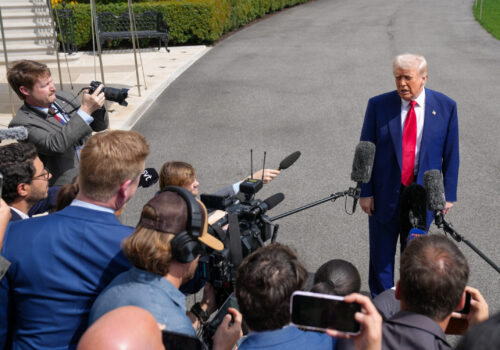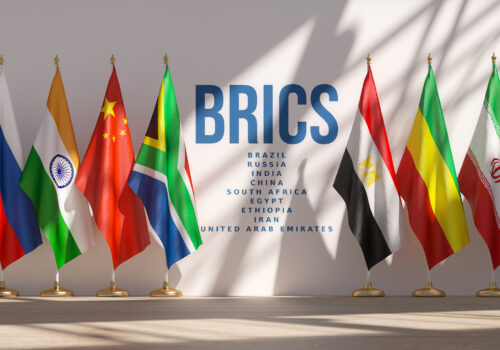The US dollar has served as the world’s leading reserve currency since World War II. Today, the dollar represents 58 percent of foreign reserve holdings worldwide. The euro, the second-most-used currency, accounts for only 20 percent of foreign reserve holdings.
But in recent years, and especially since Russia’s 2022 invasion of Ukraine and the Group of Seven (G7)’s subsequent escalation in the use of financial sanctions, several countries have signaled their intention to accelerate efforts to diversify away from dollars.
This first-of-its-kind project on dollar dominance by the Atlantic Council’s GeoEconomics Center
- Analyzes why the dollar is currently the world’s dominant reserve currency,
- Presents indicators for tracking progress by members of the BRICS grouping of emerging economies in creating an alternative financial infrastructure, and
- Creates a novel framework and data set for evaluating strengths and weaknesses of the world’s major currencies
Dollar dominance remains strong in reserves, trade, and transactions
Key takeaways

Tracking the dollar’s international use
What does it take to be a reserve currency?
The table below identifies the six essential qualities of a reserve currency. This new analysis evaluates the currencies included in the IMF’s Special Drawing Rights basket as well as the Indian rupee and Russian ruble against the criteria and allows us to demonstrate why the dollar is the global reserve currency.
Amid global economic uncertainties, could the euro go global?
Rising US debt, trade tensions, and geopolitical instability have renewed debate over the dollar’s dominance and whether the euro could serve as an alternative. While Europe offers institutional stability and appeal for trade diversification, limited joint debt issuance, fragmented capital markets, and external pressures from China undermine the euro’s global reach. Without stronger political unity and long-term strategy, the euro may remain regionally strong but constrained as a global currency. An in-depth analysis on the euro’s global potential can be found here.

BRICS summit in Brazil
The 17th annual BRICS Summit in Rio de Janeiro, Brazil, made little mention of de-dollarization. Instead, members reiterated financial cooperation proposals—including the expanded use of domestic currencies—that originated under Russia’s 2024 presidency. The main initiative highlighted in the July 2025 communiqué focused on continued thematic discussions around the BRICS Cross-Border Payments Initiative (BCBPI) strategy, also launched during the Kazan summit.
The BCBPI strategy encompasses three key projects:
While these projects might offer efficiency and cost benefits to BRICS members, they would also enable them to settle transactions bypassing the US-led financial system. Therefore, the projects would provide mechanisms for countries such as Russia to evade sanctions, and others to evade secondary sanctions implications—inevitably diminishing the effectiveness of the US economic statecraft toolkit. Additionally, advancements in financial technology and payment infrastructure are now supporting the growing demand to “de-dollarize” among BRICS members.
BRICS does not need to look far for inspiration
FOR A MESSAGING MODEL — SPFS
Russia’s System for Transfer of Financial Messages (SPFS) was developed in 2014 as an alternative to the widely used SWIFT messaging system. By 2024, SPFS was connected to 550 organizations across twenty countries, including China, Kazakhstan, and Kyrgyzstan. In Novemeber 2024, the US Treasury emphasized the risks of sanctions evasion associated with SPFS. However, SPFS still lacks SWIFT’s international connectivity and continues to have operational limitations.
FOR A CLEARING SETTLEMENT AND MESSAGING MODEL — CIPS
China’s Cross-Border Interbank Payment System (CIPS), launched in 2015, combines messaging and settlement for cross-border renminbi payments. As of September 2025, CIPS had 176 direct participants. In 2024, the annual business volume was over $24 trillion. CIPS continues to be a part of China’s effort to internationalize the renminbi, and could serve as a model for BRICS Clear.
FOR A DIGITAL CURRENCY MODEL — mBRIDGE
Project mBridge is a cross-border digital payments network that connects Hong Kong, Thailand, the UAE, Saudi Arabia, and China through their central bank digital currencies (CBDCs). At this stage, mBridge has the capacity to manage up to $190 million worth of transactions annually. All founding BRICS members have piloted their CBDCs and could leverage this project as a model for BRICS Bridge. In October 2024, Chinese state media stated that the new BRICS plan “is likely to draw on the lessons learned” from mBridge.
While the recent communique mentions several financial mechanisms—including local currency financing through the New Development Bank and enhanced payment systems—the language emphasizes ongoing deliberations rather than implemented solutions.
These initiatives are still in formation phase and face challenges:
- Many in the BRICS bloc are now more focused on managing trade risks, negotiating deals, and therefore avoiding spotlighting any de-dollarization efforts. Since the 2024 summit, the member states’ public ambitions have been significantly lowered.
- Proposals continue to deliberately avoid elaborating on the specifics, including on currency management and technical developments. These discussions could generate disagreements between BRICS member states on economic terms—as they evaluate their exposure to volatile or isolated financial markets—and on political terms as countries will want to avoid encouraging the internationalization of a geostrategic rival’s currency.
- Inconsistency in the BRICS de-dollarization agenda will continue as India, more cautious about severing ties with the US and dollar, takes on the presidency in 2026.
A scattered approach to dedollarization
This section provides a comprehensive analysis of each country’s dedollarization efforts. It identifies and tracks two key indicators of the strength of the alternative financial infrastructure China is building: China’s swap lines with the BRICS countries and membership in China’s Cross-Border Interbank Payment System (CIPS).
Acknowledgements
Authors: Alisha Chhangani and Lize de Kruijf
Contributions from: Oyinkansola Akin-Olugbade, Mary Kate Adami, Mondrita Rashid, Israel Rosales, Ryan Murphy, and Grace Kim
Visual design: Nancy Messieh, Andrea Ratiu, and Michael Currie
Thank you to Maia Nikoladze and Mrugank Bhusari for their work on originally designing, researching, and developing this project
Related content
Stay connected
Sign up to receive emails on new research & reports, program highlights, and events.



